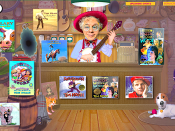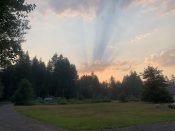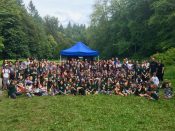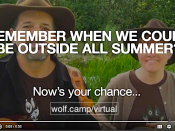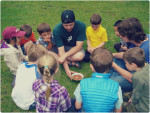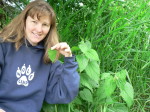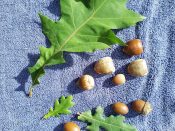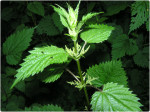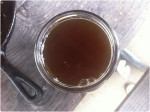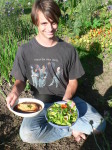I shied away from my original title ‘Teaching Herbalism to Kids’ for this article because I think “involvement” is a more accurate term — learning herbalism in particular is about involving the student via projects and activities. Think of how language is best taught: total immersion. Herbal and botanical education is no different. So later in this article, I will delve deep into the following ideas for involving children in herbal education:
- Ideas for Direct Hands-On Activities
- Plant Walks & Hiking Forays
- Potted Plants & Personal Gardens
- Having A Plant Friend
- Home Herbal Kit & Notebook
- Easily Accessible Educational Materials
- Community Education Opportunities: Camps & Classes
- Cooking With Wild Edibles & Culinary Herbs
- Teach By Example: Cultivating Your Own Practice
- Let Them Be Teacher
- Herbal Games
One of my fond childhood memories is of my own tiny garden. My mom gave me a little plot of land that was all mine — I could decide what to plant, when to water, and if to weed it. I got to be outside, digging around in the dirt, emulating my mom as she worked in her own garden. I got to have the ‘hands on’ experience — if I watered, my plants grew. If I neglected them, they died and the ‘weeds’ moved in. I think that this memory has stuck with me for so long (I must have been 5 or 6) because I had the autonomy to discover, learn, and play in my own little garden area.
Hands-on exposure to plants in particular is one of the easiest ways to give children, or students of any age, profound learning experiences, because fresh material is always at hand, giving children opportunity to learn via both their head and their hands, as well as other senses like taste and smell. Fresh, hands-on material offers fun ‘reinforcement’ of information via projects and activities that create a lasting love for learning in general, and of herbalism or botany in general.
Further, herbal studies offer the start to a lifelong friendship with plants as well as the environment as whole. To realize this broader goal, it’s important that kids are active participants in their own education, rather than passive recipients who are told exactly what and when to learn. While structured schedules and core educational elements (math, science) are important, as a society we have neglected the freedom, curiosity, and educational experience that comes through play, nature exploration, and hands-on outdoor activities.
Here at Wolf Camp, we incorporate these same lessons into our camps, classes and workshops. Of course, all kids (and adults) have different learning styles, and these styles can all be accommodated in herbal education. In fact, our day camp entitled Wild Cooking & Herbology is like a little college course and is pretty much the same thing we bring to our adult students during workshops. Bottom line is that it’s always best to combine the head (info download) with the hands-on learning.
Basically, our rule of thumb is to not bother teaching a plant unless we’re going to utilize it during the lesson. The theoretical is often worthless without the practical. Come to think of it, that’s probably a good rule of thumb for life in general. Okay, here we go with a description of herbal educational ideas:
1) Direct Hands-On Activities
One of my favorite parts of our overnight herbal camp is teaching herbal projects and activities. Making a salve or an herbal cream is a fun activity that all members of the group can participate in, and it helps the kids become familiar with a plant. At Wolf Camp, we like to teach one or two plant families per day, pairing each plant family with a discussion, an activity, and a project. For example: The Mint Family
Start the day with a mint family member tea (i.e, peppermint tea). Then, a discussion/lecture about mint family characteristics, supplemented with stories (I like Shanleya’s Journey), information and pictures from books, and live demonstrations (i.e, a garden box of different varieties of plants, or bundles of different mint family members that they will get to take home). This is followed by an activity, such as creating mint family projects (i.e, lavender sachets or rubbing cards from tracing paper over a plant), or a more involved project like creating an herbal spray, syrup, cream, or salve that includes members of the mint family, with explanations of what their uses are and why we are using them.

I specify that this is ‘direct’ because it’s important to let the kids be involved in (at least) some to most of the preparation. Let your child do the stirring, chopping (carefully, of course), pouring, harvesting, and processing during projects. This creates an ‘active’ participation in the lesson or project.
Some more ideas include: making herbal medicine, i.e, a salve, a tincture, a syrup, a cream, an infusion (tea); crafts with plant material, i.e, making cordage, natural dyeing with plant pigments, making pictures with flowers, anything the imagination gives….
2) Plant Walks & Hiking Forays
The goal of a plant walk or hike is to get outside and notice the different plants and habitats. Exploration is a key method for learning, and it is especially important in our ‘computer age’ for kids to get outside and explore.
Plant walks can be as simple as walking through your backyard, or as complex as hiking or backpacking through different bioregions. Here in the Pacific Northwest, we have a variety of bioregions that each have their diverse array of plants.
For backyard exploration, start with the plants that are the most ‘common,’ or native in your region. For example, here in western Washington, I would begin with plantain, dandelions, and pineapple weed. These plants are usually scattered throughout the yard and are easy to identify. Learn the characteristics of each plant (what shape is its stem? are the leaves opposite, alternate, or…? does it have a flower? if so, what is the shape and color? etc), and then use a field guide or other botanical/herbal book to study the plant in depth.
Another idea for a plant walk in the backyard or nearby area is to have your child find which plants are similar or different. How many plants in the area have similar characteristics? This is a great way to introduce the idea of plant classification and the taxonomy of the plant kingdom.
Hikes or backpacks can take advantage of moving through different bio-regions. For example, if you are hiking in the cascades, you might start in a temperate rain forest and move up through sub-alpine and then alpine zones. Notice the differences in plant life. What is the same? What is new? How did the plant life adapt or change, depending on its environment. Have your child point out or even record what they learn. Compare this to the zone you live in.
I highly suggest investing in a field guide. Our top recommended field guide for our region of the PNW is Plants of the Pacific Northwest Coast by Jim Pojar.
3) Potted Plants & Personal Gardens

4) Plant Friend
Ah, the plant friend. Give each child total responsibility to care for a potted plant in the house. It’s a great lesson no matter what happens, and can progress to care for animals later, and eventually the responsibility of caring for people.
5) Home Herbal Kit & Notebook
Use plants as medicine! Every week, find a new plant in Rosemary Gladstar’s Medicinal Herbs: A Beginner’s Guide: 33 Healing Herbs to Know, Grow, and Use and follow her directions to find, cultivate, harvest, process and store each plant, and in one academic year, you’ll have a full apothecary at home! For example, for stings or bug bites, you’ll have plantain always at hand. For insomnia or anxiety, chamomile tea. For upset stomach and chill, ginger, and so on.
6) Educational Materials easily accessible at home
- Shanleya’s Quest and Botany in a Day by Thomas J. Elpel
- Enchanted Forest coloring book by Johanna Basford
- field guides
7) Community Educational Opportunities + Camps / Courses
- Herbal festivals
- Lectures at community colleges
- Conservation volunteer work opportunities through your local jurisdiction
- Herbal camps and classes. These are proliferating and are a great way for them to meet other kids who have similar interests, and to develop/deepen and continue their own herbal education. It is really wonderful that there are so many outdoor schools, camps, weekend workshops, and courses available right now throughout the country.
8) Cooking
Letting children help you cook offers constant exposure to plants. Help them season the food, pick and eat the weeds for garden salad, decorate with edible flowers, and follow recipes in Edible Wild Plants by John Kallas, Ph.D. which is by far the best book out there for this purpose.
9) Teach By Example: Pursue Your Own Herbal Education
I added this as a little ‘extra’ idea, but I think it is key! As a parent, guardian, adult, instructor/teacher, or however you identify, it is important that you kindle your own love for plants and herbalism, and that you continue to fuel your own herbal education.
10) Let them be the Teacher
Let them teach you the material. It fosters confidence, leadership, and reinforces the material. You only know a subject as well as you can teach it. “If you want to learn something, read about it. If you want to understand something, write about it. If you want to master something, teach it.” ~ Yogi Bhajan
11) Herbal Games
TBA:) – Hannah
*** For educational purposes only. This information has not been evaluated by the Food and Drug Administration. This information is not intended to diagnose, treat, cure or prevent any disease. We recommend that you consult with a qualified health care practitioner before using herbal products, particularly if you are pregnant, nursing or on any medications. ***
*** Please read our Honorable Harvesting Guidelines before harvesting any plant material. The final guideline is of utmost importance: “Never put anything in your mouth unless you are 100% sure it is safe to ingest.” ***
 Hannah began her apprenticeship at Wolf Camp in 2013 and graduated as a lead herbal instructor in 2014. Join Hannah and other Wolf College wild chefs during our annual Wild Cooking & Ethnobotany Expedition: The Herbal Foray the second week of July on Lake Sammamish near Seattle.
Hannah began her apprenticeship at Wolf Camp in 2013 and graduated as a lead herbal instructor in 2014. Join Hannah and other Wolf College wild chefs during our annual Wild Cooking & Ethnobotany Expedition: The Herbal Foray the second week of July on Lake Sammamish near Seattle.
Hannah graduated from the University of Oregon in 2014 with a Bachelor’s Degree in Foreign Languages. She has her own blog, where she writes about her love for crafts, animals, plants, cooking, and the outdoors: rainmountaincrafts.com

